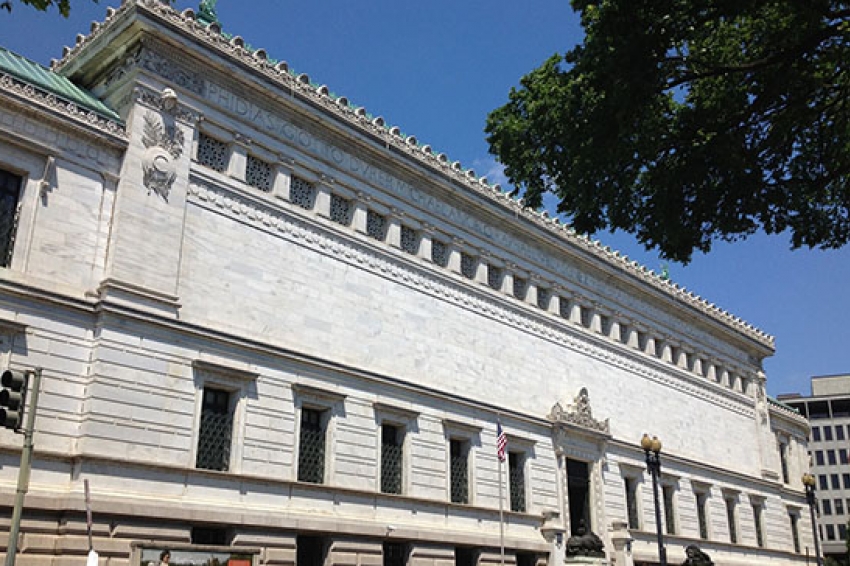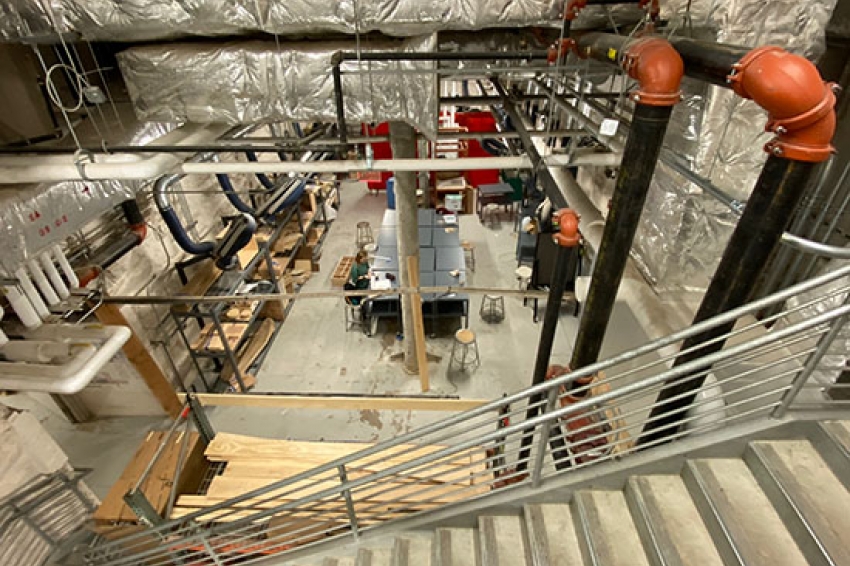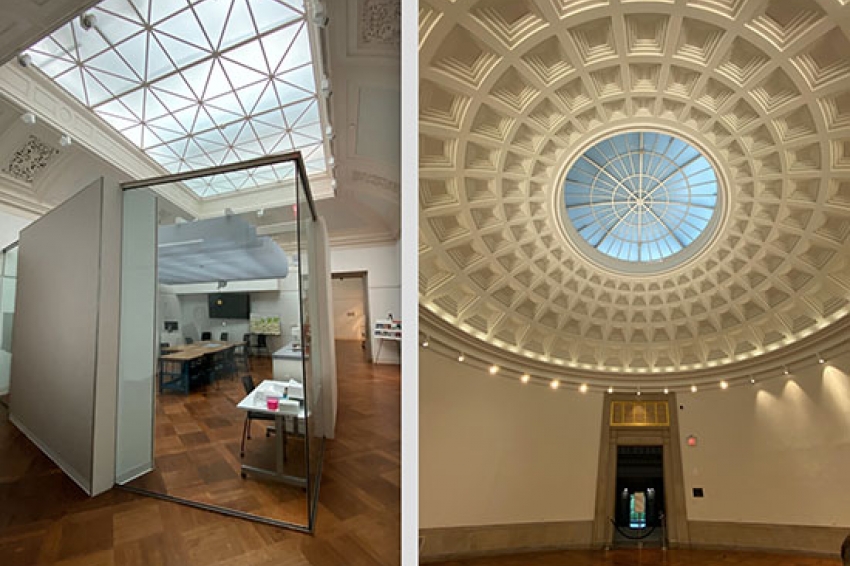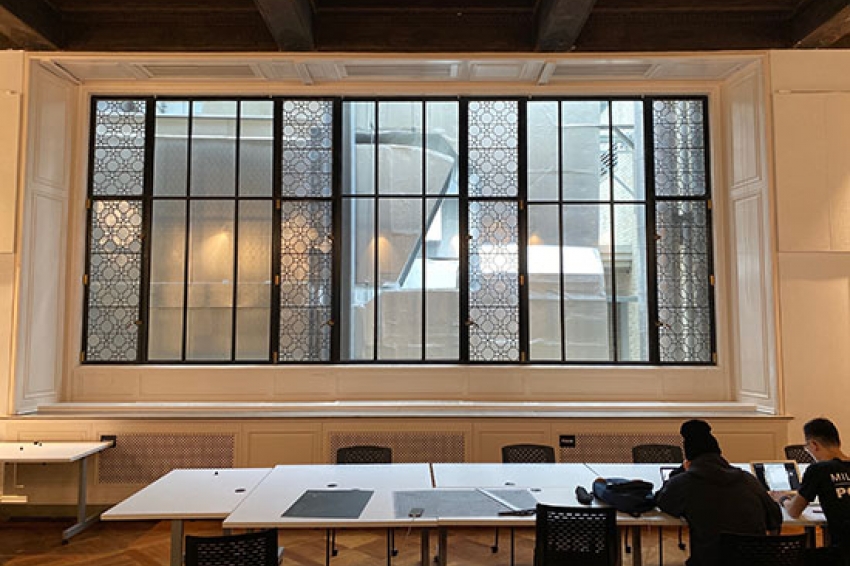Originally published on The Chronicle of Higher Education, November 20, 2019. By Lawrence Biemiller.
In Washington, the landmark building was called simply “the Corcoran” when it housed both a beloved museum and an art school. Now an intricate makeover has turned former galleries into classrooms and the old coal bunker into a woodworking shop.
Often the most complicated parts of a campus project go unseen by all but a handful of facilities staffers allowed behind locked doors and into attics and basements. So let’s take a moment to celebrate the newest architectural triumph in Washington that almost no one will ever visit: a four-story, three-dimensional jigsaw puzzle of structural steel, modern air-handling units, ductwork, and emergency stairs, all shoehorned into a modest light well between the 1897 and 1928 wings of the Corcoran School of the Arts and Design.
“What we did in that courtyard was incredibly difficult,” says Timothy J. Duffy, vice president and director of technical services at the architecture firm Leo A Daly, which has overseen extensive — and essential — renovations to the art school’s home. “You come to embrace these challenges.”
A light well that architects referred to as “the courtyard” (left) was the key to a variety of upgrades in infrastructure and safety, including an emergency-exit stairway. The stone columns in the grand atrium (right) are supported on cast-iron columns in the basement. Chronicle photographs by Lawrence Biemiller.
The project, which began in 2016, has offered more than its fair share of challenges. When the Corcoran Gallery and College of Art + Design was dissolved, in 2014, after years of financial struggles, the outdated buildings and the lively art school were taken over by George Washington U. The plan was to consolidate the art school, then spread out among seven locations, in the Corcoran buildings, while also retaining the most magnificent of the former museum’s galleries for use by the National Gallery of Art, which inherited the lion’s share of the Corcoran’s collections.
The 138,000-square-foot project had to be done on a tight budget — it was value-engineered from $80 million down to $53 million — and the classrooms had to be kept open for use. To complicate matters, the site is in the crowded heart of downtown Washington, just two blocks from the White House. And the main building, designed by Ernest Flagg, is on the National Register of Historic Places and is protected by District of Columbia preservation rules. “To put one nail in a wall, we had to get three reviews,” says Jess Kim, senior project architect for Leo A Daly.
The 1897 main building and the 1928 addition were “radically different” in construction, Duffy says, and the older part had several unusual aspects, including “Metropolitan slab” floors — gypsum and wood chips reinforced with piano wires. “We had to do some due diligence,” he says, to be certain that the floors were safe. Also, the stone columns in the main atrium rest on basement-level cast-iron columns fireproofed with plaster. Engineers determined that they were sound, but that no additional load could be added.
The two buildings had clearly gone decades without infrastructure upgrades, but complete plans existed for neither. The basement, Duffy says, contained “a gaggle of pipes and flues, much of which no one knew whether it was live or not.” Electrical gear, fire-suppression equipment, and plumbing were all inadequate or worse. Americans With Disabilities Act compliance was scanty, he says, adding that the Department of Justice had a Corcoran file with “dozens of ADA citations.”
The Leo A Daly team began by fitting academic needs to spaces, while working around issues like load-bearing walls and a floor plan in which each gallery opened into the next — fine for a museum but not for classrooms. Then the team sorted through the infrastructure needs and worked out how to do the necessary construction while keeping classrooms open for use during the academic year. “We developed a pretty complicated phasing,” Duffy says.
A sub-basement that once held coal-fired boilers now houses woodworking and metalworking studios. Chronicle photograph by Lawrence Biemiller.
Kim notes that the team tried to keep noisy activities away from quieter ones, so that woodworking and metalworking ended up in the sub-basement; ceramics, lithography, and painting in the basement; and design programs on the second floor. Classrooms, computer labs, and studio and lounge spaces are scattered throughout. One lounge has an imposing medieval fireplace that was built into the 1928 addition; nearby the Salon Doré — an elaborate room created in 1770 for a Parisian mansion — is available for special events.
To make circulation work upstairs, glass walls were added to divide several of the former galleries into rooms and hallways without compromising the original design or appearing to be part of it. “Anything we do in here has to be reversible,” says Duffy, involving only the “most minimal touching of the structure.”
Partial-height glass walls (left) allow circulation through former museum galleries on the second floor without disturbing classes. Partial ceilings within the newly enclosed spaces support drop-down electric and data connections. A rotunda (right) will remain as a gallery space. Chronicle photograph by Lawrence Biemiller.
Yet to open are the imposing second-floor spaces that will be used by the National Gallery. These too presented challenges: They had to be designed to the art museum’s exacting temperature-and-humidity standards — but the original exterior wall was uninsulated. Insulation and a new interior wall were added, though only the closest inspection reveals that the galleries’ dimensions have changed ever so slightly.
University officials describe the work completed so far as the first phase of renovations. Overhauls of the exterior stonework and of the extensive skylights will happen sometime in the future. In the meantime, visitors can enjoy the Corcoran’s renovated spaces and 50-plus new toilets. If they know where to look, they can even catch a glimpse of the four-story jigsaw puzzle in the light well from a window in the first-floor student lounge.






